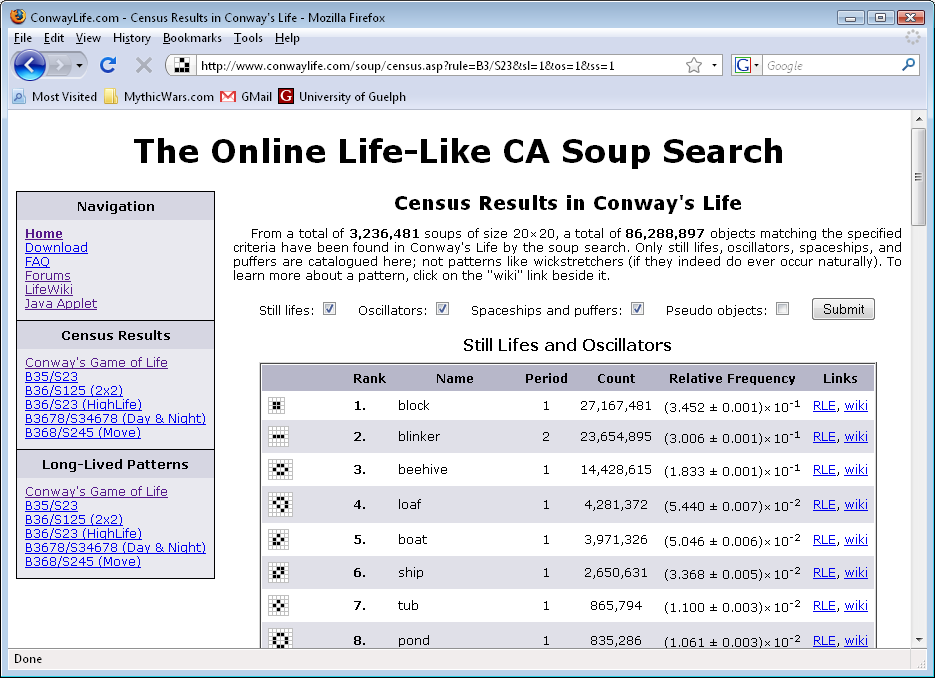The Online Life-Like CA Soup Search
UPDATE [April 17, 2015]: The Online Life-Like CA Soup Search has been offline for some time now (due to being written in ASP, and me now only running websites on Linux hosts, which means I would have to re-code it entirely in PHP). However, I am happy to announce that Adam P. Goucher has recently released a new distributed soup search script called Catagolue. Not only is this script much faster than mine, but it also has many other improvements, such as being (much) better at distinguishing different objects that are near each other, and being more cryptographically secure.
See this forum thread for the announcement as well as some discussion of discoveries made by the search so far.
Today I’m “officially” announcing the Online Life-Like CA Soup Search, though some of the folks over at the ConwayLife.com forums have been helping me test it out for a couple of weeks now.
As I mentioned in this post, one way to learn about the general behaviour of Conway’s Game of Life (or any other Life-like cellular automaton) is to generate random patterns and see what stable patterns they typically evolve into (if any). If you’ve played around with Conway’s Game of Life, then you more than likely are very familiar with blocks, blinkers, beehives, loaves, and maybe even pulsars, simply as a result of drawing random gibberish on the grid and letting it evolve. This is exactly the idea behind the Online Life-Like CA Soup Search, just on a larger scale — what if we had lots of people’s computers drawing random gibberish on Life grids, letting them evolve, and storing the resulting patterns in a communal database?
This method of collecting patterns in Life is known as a census, and to my knowledge it has been carried out on a relatively large scale twice in the past; once by Achim Flammenkamp (results here), and once by Andrej Okrasinski (results linked in the first paragraph here). As we would expect, the block is by far the most common still life, and the blinker is by far the most common oscillator. If we scroll down a bit, we see that the pulsar is the fourth most common oscillator (which is reasonably surprising, given its size). Scrolling much past that, we get into the interesting stuff — objects that no reasonable person has ever seen from drawing random stuff and seeing what it evolves into, simply because they occur so infrequently.
So why bother doing another census if two rather large-scale censuses (censi?) have already been carried out? My reasons are threefold:
- There has never (to my knowledge) been a census of any other Life-like cellular automata conducted. The Online Life-Like CA Soup Search is completely general in that it can conduct a census of any Life-like rule (assuming that rule is stable, of course). Censuses have already been started for five other rules, including 2×2, Day & Night, HighLife, and Move. Because some of these other rules have been studied relatively little, this is an easy way of discovering new yet fundamental patterns in them. For example, it didn’t take long for the soup search script to uncover a c/8 line puffer in the 2×2 (B36/S125) rule; the very first known pattern that exhibits infinite growth in 2×2!
- Previous soup searches were limited in that they only looked for very specific types of objects — usually still lifes and oscillators (though Achim Flammenkamp did a search for spaceships and puffers that can be viewed here). The Online Life-Like CA Soup Search searches for still lifes, oscillators, spaceships and puffers all at once, and even gets pseudo objects (such as the bi-block) as well.
- Multiple users can run the script and contribute to the results simultaneously. Rather than just having one person run a script that they themself wrote, the Online Life-Like CA Soup Search works by having users download a script and that script uploads results to the central database. This obviously provides a huge speed-up, and allows the census to continuously improve and expand.
So what are you waiting for? Visit the Online Life-Like CA Soup Search, download the script, and put your computer’s CPU cycles to good use!


Recent Comments